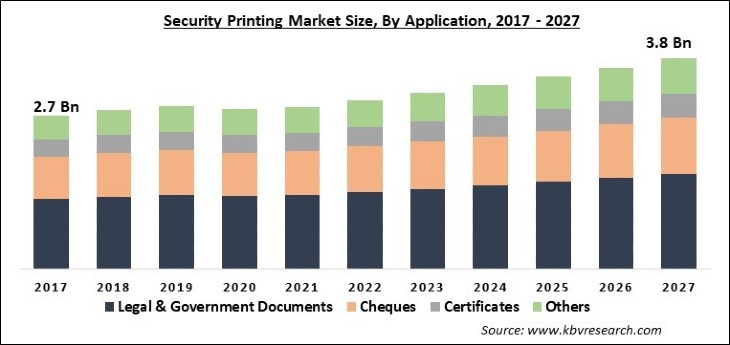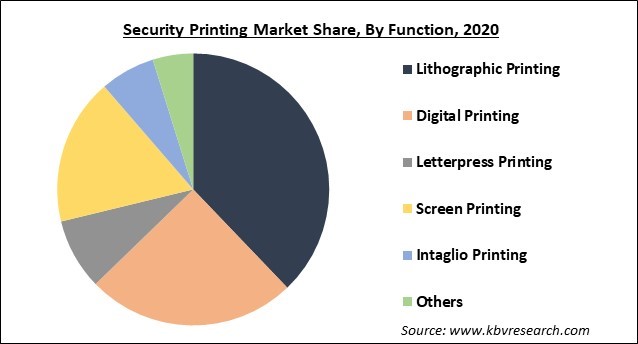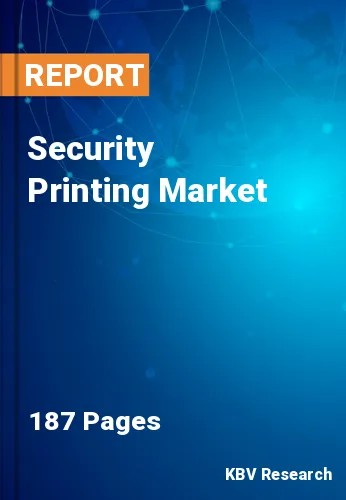The Global Security Printing Market size is expected to reach $3.8 billion by 2027, rising at a market growth of 4.5% CAGR during the forecast period. Security printing is primarily utilized for printing items which requires authentication like postage stamps, identity cards, passports, product authentication, banknotes, and stock certificates. Security printing includes holograms, copying marks, security threads, watermarks, anti-magnetic inks, serial numbers, micro-printing, special paper, and intaglio printing. With the help of security printing, it is possible to minimize the number of growing illegal activities like counterfeiting, tempering, and forgery.
The major factor driving the growth of the market is security inks. Similarly, the implementation of laws along with security regulations is anticipated to fuel market growth in the coming years. Additionally, tampering & alteration in branding of industry products and growing fraudulent activities in tax & postage stamps, financial institutions, and personal identities are some other determinants boosting the market growth. Moreover, growing awareness about counterfeit and fraud activities among customers is projected to boost market growth in the forthcoming years.
Additionally, security printing ensures the necessary aspects of protection due to which several computer systems are dependent on it. Moreover, holographic stickers are used to protect various software products against forgery. Holographic stickers are designed in such a way that it gets tear when it is detached from the product. Thus, security printing is in high demand among the manufacturers of above-mentioned items as it ensures the customer that the product has not been modified after the dispatch, thereby, these kinds of security measures are necessary to gain the trust of the customer.

Due to the outbreak of the COVID-19 pandemic, various industries experienced a negative impact including the security printing industry. At the beginning of the pandemic, Asia-Pacific and Europe were the regions that were severely affected by it. During the initial phase of pandemic, the number of COVID-19 patients drastically increased in these regions. Keeping in view the growing transmission rate of COVID-19 pandemic, the governments of several nations-imposed lockdown restrictions and other such norms. The imposition of lockdown hampered the production of security printing as there was a shortage of labor.
For specific applications of security printing, manufacturers are focusing on designing new products as the demand for new products is increasing based on their utilization at different places. In addition, the new products are integrated with enhanced security features that are very effective at several applications. Additionally, the finance and banking sector deals with the printing of cheques, banknotes, identity cards, stock certificates, and authentication and hence these sectors are witnessing massive application of security printing.
For better regulation and governance, several manufacturers in the market are focusing on bringing advancements in technologies that are being used in currency printing. The presence of fake currencies in the market has a negative impact on the economy of nations as the international value of the original currency is getting reduced, which significantly slows down the economy of nations. Moreover, the spread of fake currency has a direct effect on the prices of commodities. Thus, governments across the globe are implementing measures to eliminate or minimize the presence of fake currencies in the economy.
As the world is rapidly evolving, technological advancements are also growing. Due to these technological advancements, the nations are moving towards digitalization and a cashless economy. Cashless economy is the physical stream of national denomination being replaced with online or digital platforms like the launch of plastic cards, internet banking, and online transactions. This evolution has reduced the use of national currency due to which, security printing is witnessing a slowdown in its demand.

Based on Function, the market is segmented into Lithographic Printing, Digital Printing, Letterpress Printing, Screen Printing, Intaglio Printing and Others. In comparison to other forms of printing, lithographic printing offers a more consistent and high quality of the image. Further, the latest in-line multi-press print systems integrate holographic application, numbering, intaglio, flexographic printing, rotary screen, and imaging of variable data allowing a single-pass and cost-effective operation. Moreover, lithographic printing is majorly used for asset management, government and corporation printing, brand protection, event pass & tickets generation, and cheque & value documents printing.
Based on Application, the market is segmented into Legal & Government Documents, Cheques, Certificates and Others. The counterfeiting practices are rampant in the printing of banknotes, postage stamps, stock certificates, contraband, identity cards, and passports. Moreover, security printing helps in protecting the aforementioned documents from counterfeiting and forgery. Banking Financial Services and Insurance (BFSI) and supply chain are the major end-market verticals that are using security printing. Further, birth & death certificates, unique personal IDs, legal stamps, driving licenses, and passports are only issued by legal authorities.
| Report Attribute | Details |
|---|---|
| Market size value in 2020 | USD 2.9 Billion |
| Market size forecast in 2027 | USD 3.8 Billion |
| Base Year | 2020 |
| Historical Period | 2017 to 2019 |
| Forecast Period | 2021 to 2027 |
| Revenue Growth Rate | CAGR of 4.5% from 2021 to 2027 |
| Number of Pages | 187 |
| Number of Tables | 304 |
| Report coverage | Market Trends, Revenue Estimation and Forecast, Segmentation Analysis, Regional and Country Breakdown, Companies Strategic Developments, Company Profiling |
| Segments covered | Function, Application, Region |
| Country scope | US, Canada, Mexico, Germany, UK, France, Russia, Spain, Italy, China, Japan, India, South Korea, Singapore, Malaysia, Brazil, Argentina, UAE, Saudi Arabia, South Africa, Nigeria |
| Growth Drivers |
|
| Restraints |
|
Based on Regions, the market is segmented into North America, Europe, Asia Pacific, and Latin America, Middle East & Africa. The Asia-Pacific is anticipated to exhibit a significant growth rate over the forecasting period. This prominent growth in the region is supported by growing implementation of the latest technology associated with security printing in nations such as Japan, China, and India. Additionally, the growing concerns about fake currency, terror funding, and corruption are driving the growth of the regional market. Moreover, determinants like alternative modes of payments (including bank checks and payment cards), large-scale ID programs initiated by companies, and high demand for cash transactions are creating new growth avenues for the regional security printing market.
Free Valuable Insights: Global Security Printing Market size to reach USD 3.8 Billion by 2027
The market research report covers the analysis of key stake holders of the market. Key companies profiled in the report include Document Security Systems, Inc., Agfa-Gevaert N.V. (IG Farben), Ennis, Inc. (Printegra), Graphic Dimensions, Inc., Plus Technologies LLC, TROY Group, Inc., Wellspring Software, Inc., Amgraf, Inc., Graphic Security Systems Corporation, and Printech Global Secure Payment Solutions LLC.
By Function
By Application
By Geography
The security printing market size is projected to reach USD 3.8 billion by 2027.
Increase in loss of confidential data and monetary loss are driving the market in coming years, however, high cost of installation, maintenance, and adoption of these solutions have limited the growth of the market.
Document Security Systems, Inc., Agfa-Gevaert N.V. (IG Farben), Ennis, Inc. (Printegra), Graphic Dimensions, Inc., Plus Technologies LLC, TROY Group, Inc., Wellspring Software, Inc., Amgraf, Inc., Graphic Security Systems Corporation, and Printech Global Secure Payment Solutions LLC.
The expected CAGR of the security printing market is 4.5% from 2021 to 2027.
The lithographic printing segment dominated the security printing market by obtaining the highest revenue share in 2020 and is anticipated to continue this dominance over the forecasting period.
Our team of dedicated experts can provide you with attractive expansion opportunities for your business.

